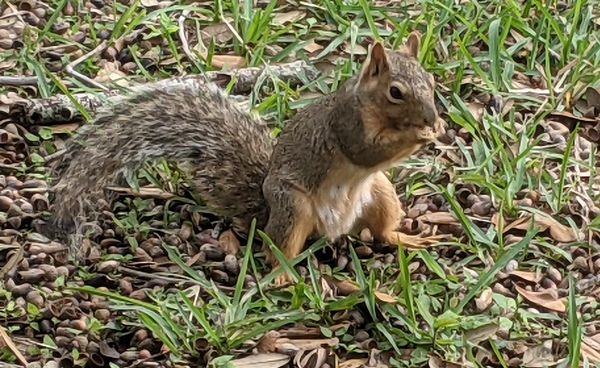by M. Kathy Raines
Leaping from branch to branch, chasing one another and outwitting birdwatchers who try to block them from feeders, an expanding population of fox squirrels now thrives in the Rio Grande Valley.

I’ve seen ground squirrels aplenty during my four decades in Brownsville, but nary a tree squirrel until recent years—an observation confirmed by other longtime residents— though maps as far back as 1994 show the creatures in the eastern two-thirds of Texas. “I have definitely seen their increase,” said Javier Gonzalez, Naturalist Educator at South Padre Island Bird, Nature Center and Alligator Sanctuary. To his surprise, Gonzalez once saw one at the center. “I was shocked!” he said. “I saw it run across Big Padre’s pen”, referring to the center’s largest gator.
Our neighborhoods, originally populated by grasses, mesquites, ebonies, cacti and other thorn scrub natives, now also flourish with live oaks, sycamores and other nonnative trees, which produce fruit, seeds and a canopy enticing to fox squirrels.
The fox squirrel (Sciurus niger), North America’s largest and Texas’s most abundant squirrel, prefers forests mixed with meadows, which offer convenient “squirrel highways”. Our neighborhoods suit them perfectly.
Squirrels, in general, have strong jaws, short, sturdy legs and flexible feet with rotating ankles. Their bushy tails warm and shield them from rain, assist with balance and, like rudders, help them swim. Tails contain large, blood-filled structures which squirrels use to regulate their temperature.
A squirrel high in a tree may bark and twitch its tail to warn others about a presumed ground predator, perhaps a dog, cat or human. Sometimes, though, especially when alerted to an aerial foe, it attempts invisibility by hiding or flattening itself against the tree. By wagging, stiffening or otherwise manipulating their tails, squirrels flirt, scold, threaten predators and otherwise communicate. Also, their grand tails may fool predators into presuming the squirrels are too large to bother with. A predator may tear off part of a lush tail while its owner escapes further harm.

A squirrel’s vision is keen, and it appears to detect reds and greens. A yellowish eye coating helps squirrels filter out sunlight and may protect their retinas. Squirrels’ hearing is sharp, and special sensitive facial whiskers, or vibrissae, assist with navigation.
Fox squirrels enjoy a varied diet: acorns, fruits, seeds, insects, eggs, buds, fruit and nuts. In cooler climates, they bury nuts in the fall, creating caches close to the surface for winter browsing, using smell, it appears, to relocate them. Fox squirrels avoid worm infestations by eating tannin-rich acorns, their mainstay; tannin is poisonous to the parasites, as well as to many other creatures. Fox squirrels, more than the similar-looking eastern gray squirrels of East Texas, often forage on the ground, sometimes far from trees.
Tree hollows, if available, provide fox squirrels with both ideal dens and nurseries. Within these, or in similarly protected areas, squirrels construct spherical nests, or dreys, of interwoven leaves and twigs, creating roundish structures with ceilings and escape routes at the bottom. Fox squirrels are polygynandrous, meaning that both males and females breed with multiple partners. Still, males compete over mates. Usually, squirrels breed twice a year, during winter and spring, and, though territorial and not very social, they may share winter nests. After six or seven weeks, they usually produce from two to four blind and helpless babies—called pups, kits or kittens and, for males, bucks—who become independent at about three months.
Fox squirrels, with their varied appetites, enjoy oranges, commercially grown nuts and other crops, which troubles producers. However, squirrels also assist with seed distribution since they sometimes forget the locations of seeds they’ve buried. Also, squirrels provide nourishment for predators like hawks, foxes and bobcats.

Many a birdwatcher frowns at these clever, furry acrobats who frighten birds and gobble up proffered birdseed. Some birders wrap their feeders in vertical wire, which squirrels have trouble traversing. Others buy a “squirrel baffle”, a wobbly metal piece that attaches to the top of a feeder which, with its slippery surface, apparently confuses squirrels. Gardening sites provide several methods for discouraging, but not harming squirrels. Here are two:
https://happygardens.com/blogs/news/how-to-squirrel-proof-bird-feeder
https://www.thespruce.com/how-to-squirrel-proof-a-birdfeeder-386581
Populations of fox squirrels appear to be stable. Like the possum, coyote and raccoon, this squirrel’s resilience and adaptability may assure its salvation with our changing climate.

